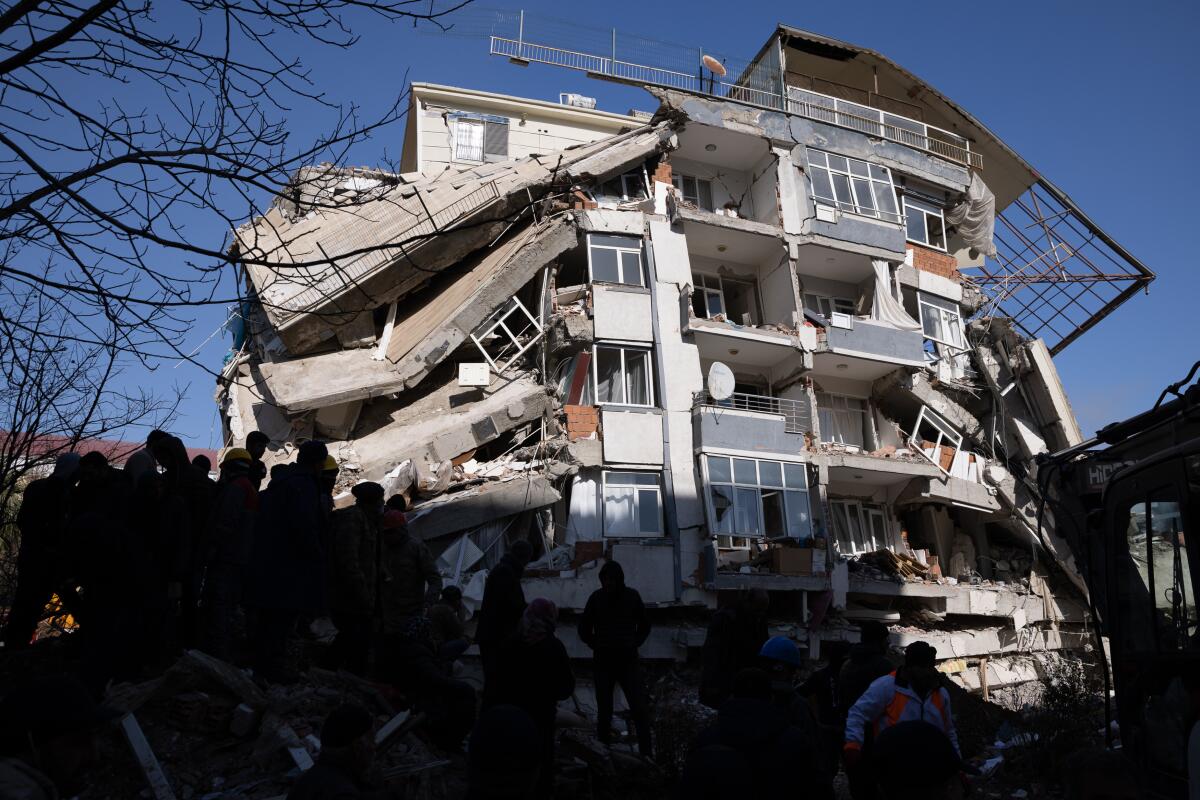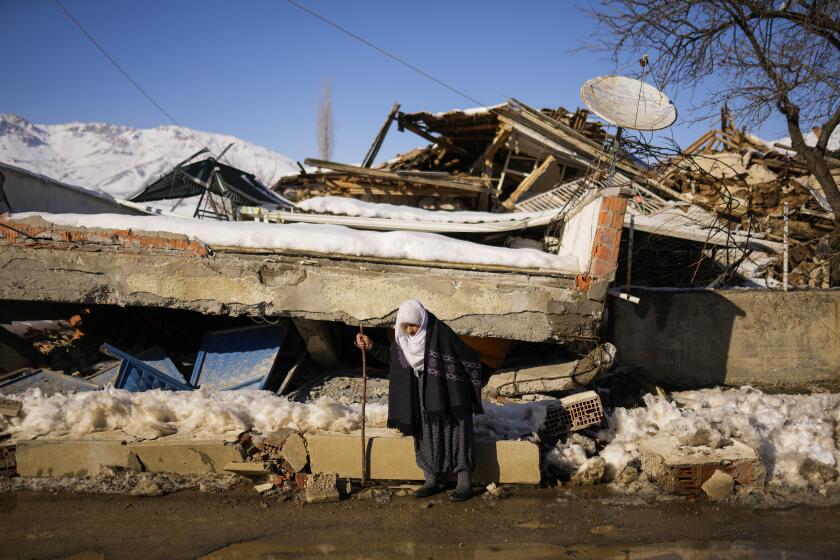Deadly warnings for California from Turkey earthquakes: What to learn from devastation

- Share via
Every catastrophic earthquake offers lessons on how we can better withstand seismic shocks and reduce loss of life.
Previous quakes in California have prompted tighter building standards for schools, seismic improvement for freeways and rules to strengthen both new construction and retrofit existing buildings.
The twin quakes last week in Turkey and Syria are among the most devastating in years and already are raising new questions about what we can learn from the destruction.
Here are some takeaways from the earthquakes and how they relate to California’s seismic vulnerabilities, focused heavily on building risks and how mega-quakes could affect the state.
1. Quakes that size happen in California
- Seismologists have been warning Californians for years about the dangers of the type of massive quake that devastated Turkey and Syria. “There will be 7.8s in our future. Absolutely. We have the faults, we’ve seen it in the past, it will happen again,” seismologist Lucy Jones, a research associate at Caltech, said.
Even back-to-back quakes are possible here. In Turkey, a magnitude 7.8 quake was followed by a magnitude 7.5, with 60 miles of distance between the epicenters. Mega-quakes that could rupture the southern San Andreas fault from near the Mexican border through Los Angeles County and beyond could trigger major aftershocks and shake cities as far away as Sacramento and San Francisco, according to documents and interviews.
Thousands left homeless by the earthquake that struck Turkey and Syria last week packed into crowded tents or lined up in the streets for hot meals.
2. Damage estimates for a catastrophic California quake would be massive
- In Southern California, 1,800 people could die in a hypothetical 7.8 earthquake on the San Andreas fault — that’s according to a scenario published by the U.S. Geological Survey called the ShakeOut. More than 900 people could die in fires, more than 600 in building damage or collapse and more than 150 in transportation accidents. Nearly 50,000 people could be injured.
- The damage could add up to $200 billion, the ShakeOut scenario estimates. Communications networks, including internet and cellphone service, could be disrupted for days or longer if telecommunications lines are severed and electricity is knocked out.
A landmark report by the USGS in 2018 estimated that at least 800 people could be killed and 18,000 more injured in a magnitude 7 earthquake on the Hayward fault centered below Oakland in Northern California.
In the days since the magnitude 7.8 earthquake struck Turkey, search-and-rescue teams, including one from Los Angeles County, have been a ubiquitous presence.
3. The Turkey devastation was worsened by lax building standards
- With well over 35,000 dead and countless buildings collapsed, the quakes last week caused destruction on an epic scale. Already officials have been investigating construction practices and have arrested some builders. Experts have said corrupt or incompetent building practices likely contributed to the scale of destruction. The Associated Press reported that even though Turkey has, on paper, construction codes that meet current earthquake-engineering standards, they are too rarely enforced.
4. California has many similar buildings likely in danger of collapse
- California officials have known for decades about flaws in non-ductile concrete construction, with many buildings having not been evaluated or retrofitted and at risk of collapse in a serious earthquake. Concrete-frame buildings were popular after World War II and line many of Los Angeles’ most famous boulevards.
- A USGS simulation said it is plausible a magnitude 7.8 earthquake in Southern California could cause 50 non-ductile concrete buildings to fully or partially collapse, with as many as 7,500 people in them.
- A 2013 Times investigation highlighted city officials’ failure to identify and fix these buildings. Since then, three cities — Los Angeles, Santa Monica and West Hollywood — have ordered retrofits. But the deadline in L.A. is decades away, scheduled for the 2040s. Many other cities with concrete frame buildings have not acted.
- Learn more about the concrete building threat:
▶ Times investigation: Buildings across L.A. have hidden risk of collapse in earthquake
▶ Why are concrete towers potentially unsafe
▶ Where L.A. stands with retrofits
5. There are other building risks in California
- “Soft-story” apartments: In the 1994 Northridge earthquake, about 200 so-called soft-story buildings — which have flimsy ground floors that are typically used as a garage, carport or for retail space — collapsed, including one apartment building in which 16 people died. Some California cities have required retrofits. Last year, L.A. announced a major milestone: More than 8,000 seismically vulnerable buildings have been retrofitted across the city at an estimated cost of $1.3 billion.
- Unreinforced brick buildings: Some cities, including Los Angeles, long ago required retrofits of unreinforced brick buildings. But a Times analysis in 2018 found that there were as many as 640 unreinforced masonry buildings in more than a dozen Inland Empire cities, including Riverside, Pomona and San Bernardino, that have been marked as dangerous but remained unretrofitted despite decades of warnings.
6. Expect breakdowns of communication, utilities after a big quake
- Infrastructure across the region would be hard hit by a major earthquake. Main freeways to Las Vegas and Phoenix that cross the San Andreas fault could be destroyed. The USGS projection found Southern California could be isolated for some time, with the region surrounded by mountains and earthquake faults. Major utilities such as gas and power would likely be severely compromised. Cellphone service would likely be limited.
7. There is much you can do to prepare
- The Times’ Unshaken project offers detailed guides on earthquake preparation. Among the highlights:
- Have an emergency kit, including a by-the-bed kit and a commute kit
- Know your neighbors
- Protect your home, inside and out
- Make a family plan
- What to do immediately when a quake hits
- A review of popular earthquake kits
- Talking to your children about earthquakes
- Retrofitting your home for better protection
- What kind of quake apps should I have on my phone?
More to Read
Sign up for Essential California
The most important California stories and recommendations in your inbox every morning.
You may occasionally receive promotional content from the Los Angeles Times.
















